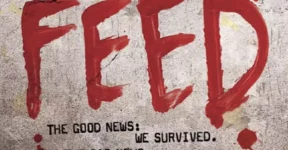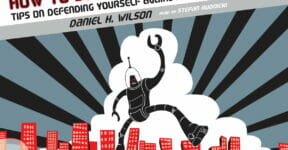If a zombie apocalypse was about to happen tomorrow, you would imagine that people have learned enough about it from books, films, and TV shows to where they should be able to defend themselves pretty well. Such an outbreak might kill hundreds of thousands, if not millions, of people, but the vast majority could survive given the amount of their collective knowledge about the monster. There are certainly more than a handful of scenarios where human civilization lives on by either obliterating all the zombies in the world, or as Mira Grant’s Feed suggests, keeping the brain-eating monsters under control.
Virus Backstory

A lot of zombie stories end when the undead are defeated or with survivors arriving at a sanctuary cut off from the rest of the world. Feed proposes an idea about a zombie outbreak, starting with a man-made airborne virus that spreads like a common cold. Although there’s no cure, people don’t just transform into zombies the moment they get infected – a peculiarity indeed, but there is a backstory to it.
Back in 2014, the medical world was in for a series of remarkable achievements. First, a young girl named Amberlee recovered from terminal Leukemia. In the same year, Dr. Kellis successfully synthesized a rhinovirus strain to get rid of the common cold once and for all. It was an overall wonderful year marked by astonishing discoveries. Medical science had finally put cancers and the common cold to their eternal ends. And then disaster happened; the two viruses through a series of unfortunate events merged into one to create an airborne hybrid.
Cancers and runny noses had become things of the past, but the new strain – subsequently known as Kellis-Amberlee or KA virus – had the most terrifying side effects ever. Since this is an airborne virus, everyone was infected. In fact, the virus was so potent that it could reanimate dead bodies and turned them into mindless cannibals. KA was initially benign in living hosts unless they died (of any causes) in which case the virus took control of the bodies, or they were bitten by an infected-resurrected corpse. Also, the transformation into a zombie almost always happened through several phases, starting with the lack of sensitivity to pain, followed by memory loss, and finally a complete conversion. Spontaneous conversion was rare, but not impossible.
Millions of people fell victim to the zombies during the early years of the outbreak, an event that would be forever remembered in history as The Rising. While it wasn’t exactly an apocalypse-level catastrophe, it took some major reformations for humanity to become adapted or adjusted to the zombies. Now, 20 years later, most people live in strictly controlled safe zones. Everybody is subjected to regular blood testing to monitor the KA virus inside their body and detect early symptoms of transformation. The authority deliberately makes the test painful because losing the pain sensation is an early sign of zombification. Rigorous decontamination protocol is put in place to prevent another outbreak as well.
As far as virology is concerned, it makes sense that a zombie outbreak caused by a virus doesn’t kill everyone. Most viruses will not want to wipe out the host species; without the host, the viruses would go extinct unless they can evolve quickly enough to develop the ability to replicate outside the human cells (in Mira Grant’s Feed, however, the KA virus can also infect animals over 40 pounds, but the principle remains).
It would actually be in the virus’ best interest to maintain a good balance between killing the hosts and keeping a good supply of new ones alive and well. Staying in a benign state until the host dies or gets bitten by a reanimated corpse seems like a pretty good strategy. Based on that theory, the zombie outbreak becomes survivable and allows human civilization to continue to exist in a condition that’s as normal as a modern society can.
Today’s Technology
Thanks to the virus’ balancing strategy and the fact that humans can actually do their day-to-day activities in safe zones, the zombies never had a chance to destroy the civilizations. Not much has changed in terms of technology. People still have electricity, plumbing systems, and the Internet. The government still functions, and in fact the story in the novel happens during the height of a presidential campaign in the United States.
One of the most notable changes is that people now consume the media differently. During the major outbreak in 2014, traditional news outlets were too sluggish to provide meaningful reports about the zombies. Many outlets were overly tied to the government and big companies, who were also reluctant to give “zombie news” a place in the front pages of newspapers and on prime time schedules.
But people knew zombies were real, and that’s where the distrust of conventional media grew. People saw that some Twitter feeds and blog posts offered real-time stories accurate to what the public saw on the streets. Given intense enough emergencies that threatened humanity as a species, it turns out that the Internet could abandon their knack for tribalism, fearmongering, and sowing divisions. Traditional media’s reputation took a dive, and to take their place now as trustworthy news sources are online blogs run and maintained by independent journalists, professionals, and entertainers.
We think Mira Grant’s Feed can stand among some of the most creative and unique zombie fictions out there. The novel even suggests that people are aware of popular zombie fictions, and that’s why they’re not entirely in a state of panic attack during the outbreak. For example, the 1978 film Dawn of the Dead is not only mentioned, but is credited as giving some sort of guidance to help humans survive the zombies. The details in its world-building, including the backstory of the virus, and how it depicts the society in the outbreak’s aftermath prove to be quite a blend of an enjoyable, exciting read.
Do you prefer slow-moving or fast-sprinting zombies? What zombie film is most scientifically accurate? We’d love to hear from you.
Other Things You Might Want to Know
Is “Feed” by Mira Grant suitable for young readers?
Some scenes are pretty gruesome and there are some sex jokes here and there. However, the political aspect of the presidential campaign might not sound too interesting for young readers, so the novel is probably best for adults.
Popular books by Mira Grant:
Mira Grant actually is an American author named Seanan McGuire, who also sometimes uses A. Deborah Baker as a pseudonym. Some of her most popular books include:
October Daye series:
Rosemary and Rue (2009)
- A Local Habitation (2010)
- An Artificial Night (2010)
- Late Eclipses (2011)
- One Salt Sea (2011)
- Ashes of Honor (2012)
- Chimes at Midnight (2013)
- The Winter Long (2014)
- A Red Rose Chain (2015)
- Once Broken Faith (2016)
- The Brightest Fell (2017)
- Night and Silence (2018)
- The Unkindest Tide (2019)
- A Killing Frost (2020)
- When Sorrows Come (2021)
- Be the Serpent (2022)
- Sleep No More (2023)
- The Innocent Sleep (2023)
InCryptid series:
Discount Armageddon (2012)
- Midnight Blue-Light Special (2013)
- Half-Off Ragnarok (2014)
- Pocket Apocalypse (2015)
- Chaos Choreography (2016)
- Magic for Nothing (2017)
- Tricks for Free (2018)
- That Ain’t Witchcraft (2019)
- Imaginary Numbers (2020)
- Calculated Risks (2021)
- Spelunking Through Hell (2022)
- Backpacking through Bedlam (2023)
- Aftermarket Afterlife (2024)
- Installment Immortality (2025)
Wayward Children series:
Every Heart a Doorway (2016)
- Down Among the Sticks and Bones (2017)
- Beneath the Sugar Sky (2018)
- In an Absent Dream (2019)
- Come Tumbling Down (2020)
- Across the Green Grass Fields (2021)
- Where the Drowned Girls Go (2022)
- Lost in the Moment and Found (2023)
- Mislaid in Parts Half-Known (2024)
- Adrift in Currents Clean and Clear (upcoming, 2025)
Newsflesh series:
Feed (2010)
- Deadline (2011)
- Blackout (2012)
- Feedback (2016)
Some humorous zombie books you may find enjoyable:
Zombie Fallout by Mark Tufo
- Mountain Man by Keith C. Blackmore
- Hollow Kingdom by Kira Jane Buxton
- The Zombies of Lake Woebegotten by Harrison Geillor
- Gil’s All Fright Diner by A. Lee Martinez
- The Panama Laugh By Thomas S. Roche
Check out other articles by month:







